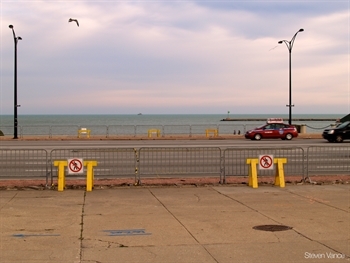
photo by Steven Vance
One of the most important Placemaking principles is “you are never finished.” As in, even after an open space is landscaped and has some outdoor furniture and becomes a park, it continues to evolve. There are incredibly valuable lessons to be learned in just watching how people use a space. I spent some time recently in Union Square Park in New York, where park designers determined that in addition to traditional park furniture like immobile benches, people wanted movable chairs. Being able to adjust your seat for the right light and proximity to others makes all the difference in making a space feel like one’s own. However, the day I was there I noticed that the bulk of the park’s bright green movable chairs were still stacked up in piles, while park users squatted, perched on steeply peaked knee walls (ouch), and sat on the sidewalk. It was clear that most users did not feel they had permission to move and open the chairs on their own. Movable chairs? Great idea. Observation? People need a little help making the chairs their own. When the park opens, staff could take a higher number of chairs and try placing them randomly around, and see how it goes from there. Observe, tweak, repeat.
In that spirit, while I’m a little late to the Queen’s party, I thought I’d extend my belated congratulations to the City of Chicago for a great case of observing and tweaking: the long-awaited re-opening of the pedestrian crosswalk at Queen’s Landing last month.
The path across Lake Shore Drive at Buckingham Fountain is named for the route Queen Elizabeth took in 1959 after her yacht traversed the St. Lawrence Seaway and disembarked to a big celebration at the lakefront. Would you make a queen walk to the nearest stoplight? Apparently not, as she strolled across Lake Shore Drive in the most direct path possible to the regal Buckingham Fountain, as have countless Chicagoans, tourists and lakefront enthusiasts ever since the official crosswalk was installed in 1988. Until, that is, 2005 when the crosswalk was removed in order to speed traffic flow.
Seemed like a good idea at the time. Traffic was backing up between multiple stoplights in that stretch of Lake Shore Drive and motorists were complaining, so the crosswalk went away to allow cars to move unimpeded.

Queen's Landing with crosswalk removed
Steven Vance
And what did the Chicago Dept. of Transportation do? Exactly what they should have done. They observed. They paid attention. And they found that, somehow, pedestrians had not gotten the memo. People liked their crosswalk in the middle of the block. It was a logical place to traverse a major highway in an otherwise pedestrian-centric zone between Grant Park and the lakefront. So they did it anyway, risking life and limb in the process.
For a department that has taken admirable steps to raise the profile of the importance of pedestrian safety with its soon-to-be released Pedestrian Plan, they saw a situation in which they needed to act. According to the department’s press release on the reinstallment of the crosswalk, CDOT Commissioner Gabe Klein stated, “There is a definite need for a well-designed, safe crosswalk for pedestrians at this location. Despite the current deterrents, people continue to put themselves at risk by crossing Lake Shore Drive at what feels like a logical crossing instead of walking to Jackson Drive or Balbo Avenue.”
And so on Thanksgiving Day we got our crosswalk back, new and improved with a countdown timer. All thanks to the power of paying attention. Let’s hear from you…where else should we be paying more attention?